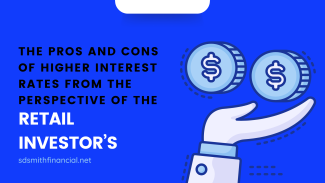
The Pros and Cons of Higher Interest Rates for Retail Investors
As a financial advisor, one of the most crucial aspects of my job is helping clients navigate the ever-changing landscape of economic conditions. Interest rates, which are influenced by central banks like the Federal Reserve, play a pivotal role in shaping this landscape. Recently, there has been a lot of discussion about rising interest rates and their implications for investors. While higher interest rates can present certain challenges, they also offer unique opportunities. Here, we'll explore the pros and cons of higher interest rates from an investor’s perspective.
The Pros of Higher Interest Rates
Better Returns on Savings and Fixed-Income Investments: One of the most immediate benefits of higher interest rates is the improved returns on savings accounts, certificates of deposit (CDs), and other fixed-income investments. For many years, low interest rates have meant that these types of investments offered minimal returns. However, as rates rise, the yields on these investments also increase, providing a more attractive option for conservative investors looking for safe and steady returns.
Increased Income from Bonds: While rising interest rates can initially lead to a decline in the market value of existing bonds, they also result in higher yields on new bonds. This means that investors purchasing bonds or bond funds in a higher interest rate environment can enjoy greater income. For those who hold bonds to maturity, the periodic interest payments become more lucrative.
Opportunities in Financial Sector Stocks: Higher interest rates can be beneficial for certain sectors, particularly financials. Banks, insurance companies, and other financial institutions often see improved profit margins when interest rates rise, as they can charge higher rates on loans and earn more on their reserves. This can make financial sector stocks more attractive to investors.
The Cons of Higher Interest Rates
Decreased Bond Prices: One of the primary disadvantages of rising interest rates is their inverse relationship with bond prices. When interest rates go up, the prices of existing bonds typically fall because newer bonds are issued at higher yields. This can lead to capital losses for investors who need to sell their bonds before maturity.
Higher Borrowing Costs: Higher interest rates lead to increased borrowing costs for individuals and businesses. For companies, higher costs of capital can result in reduced profits and potentially less investment in growth initiatives. For individual investors, higher mortgage rates and loan costs can strain personal finances and reduce disposable income.
Potential Pressure on Stock Prices: Rising interest rates can put downward pressure on stock prices. Higher rates increase the cost of borrowing for companies, which can squeeze profit margins and reduce earnings growth. Additionally, as bonds and other fixed-income investments become more attractive, there may be a shift in investor preference away from equities, leading to potential declines in stock markets.
Balancing the Risks and Opportunities
For investors, navigating a higher interest rate environment requires a balanced approach. Here are some strategies to consider:
- Diversify Across Asset Classes: Maintaining a diversified portfolio can help mitigate the risks associated with rising interest rates. By spreading investments across stocks, bonds, and other asset classes, investors can reduce the impact of volatility in any single market.
- Focus on Quality: In both equities and fixed income, focusing on high-quality investments can provide more stability. For example, blue-chip stocks with strong balance sheets and robust cash flows may be better positioned to weather the challenges of higher rates. Similarly, investment-grade bonds can offer more security than lower-rated debt.
- Adjust Duration: For bond investors, managing the duration of their bond holdings is crucial. Shorter-duration bonds are less sensitive to interest rate changes and can provide more stability in a rising rate environment.
- Consider Rate-Responsive Sectors: Some sectors, such as financials, can benefit from higher rates. Allocating a portion of your portfolio to these sectors can help capture some of the upside potential.
Higher interest rates are a double-edged sword for investors, offering both opportunities and challenges. By understanding the implications of rising rates and employing strategic adjustments to their portfolios, investors can navigate this environment effectively. As always, it’s important to stay informed and consult with a financial advisor to tailor strategies to your specific financial goals and risk tolerance. While the landscape may change, a well-considered approach can help ensure your investment journey remains on course.




